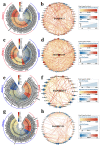Genome-Wide Identification of Brassicaceae Hormone-Related Transcription Factors and Their Roles in Stress Adaptation and Plant Height Regulation in Allotetraploid Rapeseed
- PMID: 35955899
- PMCID: PMC9369146
- DOI: 10.3390/ijms23158762
Genome-Wide Identification of Brassicaceae Hormone-Related Transcription Factors and Their Roles in Stress Adaptation and Plant Height Regulation in Allotetraploid Rapeseed
Abstract
Phytohormone-related transcription factors (TFs) are involved in regulating stress responses and plant growth. However, systematic analysis of these TFs in Brassicaceae is limited, and their functions in stress adaptation and plant height (PH) regulation remain unclear. In this study, 2115 hormone-related TFs were identified in nine Brassicaceae species. Specific domains were found in several Brassicaceae hormone-related TFs, which may be associated with diverse functions. Syntenic analysis indicated that expansion of these genes was mainly caused by segmental duplication, with whole-genome duplication occurring in some species. Differential expression analysis and gene co-expression network analysis identified seven phytohormone-related TFs (BnaWRKY7, 21, 32, 38, 52, BnaGL3-4, and BnaAREB2-5) as possible key genes for cadmium (Cd) toxicity, salinity stress, and potassium (K) and nitrogen (N) deficiencies. Furthermore, BnaWRKY42 and BnaARR21 may play essential roles in plant height. Weighted gene co-expression network analysis (WGCNA) identified 15 phytohormone-related TFs and their potential target genes regulating stress adaptation and plant height. Among the above genes, BnaWRKY56 and BnaWRKY60 responded to four different stresses simultaneously, and BnaWRKY42 was identified in two dwarf rapeseeds. In summary, several candidate genes for stress resistance (BnaWRKY56 and BnaWRKY60) and plant height (BnaWRKY42) were identified. These findings should help elucidate the biological roles of Brassicaceae hormone-related TFs, and the identified candidate genes should provide a genetic resource for the potential development of stress-tolerant and dwarf oilseed plants.
Keywords: Brassicaceae; abiotic stress; phytohormone; plant height; transcription factors.
Conflict of interest statement
The authors declare no conflict of interest.
Figures









Similar articles
-
Genome-wide identification of Brassicaceae histone modification genes and their responses to abiotic stresses in allotetraploid rapeseed.BMC Plant Biol. 2023 May 11;23(1):248. doi: 10.1186/s12870-023-04256-1. BMC Plant Biol. 2023. PMID: 37170202 Free PMC article.
-
Genome-wide identification of Brassicaceae B-BOX genes and molecular characterization of their transcriptional responses to various nutrient stresses in allotetraploid rapeseed.BMC Plant Biol. 2021 Jun 24;21(1):288. doi: 10.1186/s12870-021-03043-0. BMC Plant Biol. 2021. PMID: 34167468 Free PMC article.
-
Genome-Wide Identification, Evolution, and Comparative Analysis of B-Box Genes in Brassica rapa, B. oleracea, and B. napus and Their Expression Profiling in B. rapa in Response to Multiple Hormones and Abiotic Stresses.Int J Mol Sci. 2021 Sep 26;22(19):10367. doi: 10.3390/ijms221910367. Int J Mol Sci. 2021. PMID: 34638707 Free PMC article.
-
SHINE clade of ERF transcription factors: A significant player in abiotic and biotic stress tolerance in plants.Plant Physiol Biochem. 2023 Feb;195:77-88. doi: 10.1016/j.plaphy.2022.12.030. Epub 2022 Dec 31. Plant Physiol Biochem. 2023. PMID: 36603451 Review.
-
A comprehensive review of TGA transcription factors in plant growth, stress responses, and beyond.Int J Biol Macromol. 2024 Feb;258(Pt 1):128880. doi: 10.1016/j.ijbiomac.2023.128880. Epub 2023 Dec 21. Int J Biol Macromol. 2024. PMID: 38141713 Review.
Cited by
-
Transcription factors involved in plant responses to cadmium-induced oxidative stress.Front Plant Sci. 2024 Jun 13;15:1397289. doi: 10.3389/fpls.2024.1397289. eCollection 2024. Front Plant Sci. 2024. PMID: 38938636 Free PMC article. Review.
-
Revealing critical mechanisms in determining sorghum resistance to drought and salt using mRNA, small RNA and degradome sequencing.BMC Plant Biol. 2024 Jun 13;24(1):547. doi: 10.1186/s12870-024-05230-1. BMC Plant Biol. 2024. PMID: 38872092 Free PMC article.
-
Genome-wide identification of Brassicaceae histone modification genes and their responses to abiotic stresses in allotetraploid rapeseed.BMC Plant Biol. 2023 May 11;23(1):248. doi: 10.1186/s12870-023-04256-1. BMC Plant Biol. 2023. PMID: 37170202 Free PMC article.
References
-
- Okushima Y., Overvoorde P.J., Arima K., Alonso J.M., Chan A., Chang C., Ecker J.R., Hughes B., Lui A., Nguyen D., et al. Functional genomic analysis of the AUXIN RESPONSE FACTOR gene family members in Arabidopsis thaliana: Unique and overlapping functions of ARF7 and ARF19. Plant Cell. 2005;17:444–463. doi: 10.1105/tpc.104.028316. - DOI - PMC - PubMed
MeSH terms
Substances
Grants and funding
- 2021M692944/Chinese Postdoctoral Science Foundation
- 32212399 and 32213006/Research Start-Up Project
- 22610002/Famous Teachers in Central Plains
- 202102110006/Application of Molecular Design Breeding of Oil Crops and Intelligent Auxiliary Information System in Supercomputing Ecology, Henan Key Project of Science and Technology
LinkOut - more resources
Full Text Sources

